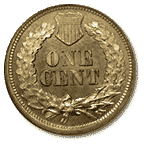
Uncovering America's Heritage... Coin by Coin
Indian Head Cent
In 1856, the size of the one-cent coin was changed. Before then, pennies were about the size of quarters! A pocket full of pennies could be quite a load to carry. So the Flying Eagle cent was created in a new, smaller size.
Then, in 1858, the Director of the United States Mint suggested that the Flying Eagle design be changed. The coin's relief was too high to be struck well. Besides that, people didn't like the design much. The new "Indian Head" design by James Longacre hit the streets the following year.
The story is told that Mr. Longacre's daughter Sarah was the model for the face on the cent, wearing the headdress of an Indian chief who visited the Mint...but there are no records to say for sure. Mr. Longacre, who was the Engraver at the Philadelphia Mint, once said that the model for the face was a Greek statue of Venus.
Between 1859 and 1864, nickel was used in these small cents (12 percent nickel, the rest copper). This made their color lighter than the older cents, so that people called them "white cents." Because of the nickel in them, people also called them "nickels." Imagine calling a penny a "nickel"!
Beginning in 1864, these Indian head pennies were made of bronze, an alloy of 95 percent copper and 5 percent tin and zinc. In 1866, the supply of nickel was used in a new five-cent coin...the one that we now call a "nickel." But that's another story...a story told in the May 2002 Coin of the Month!
As far as the Indian Head goes...well, it went pretty far. This design was used for fifty years...right up until Abraham Lincoln appeared on the penny in 1909.
—Flip




